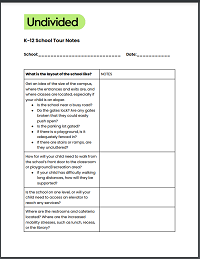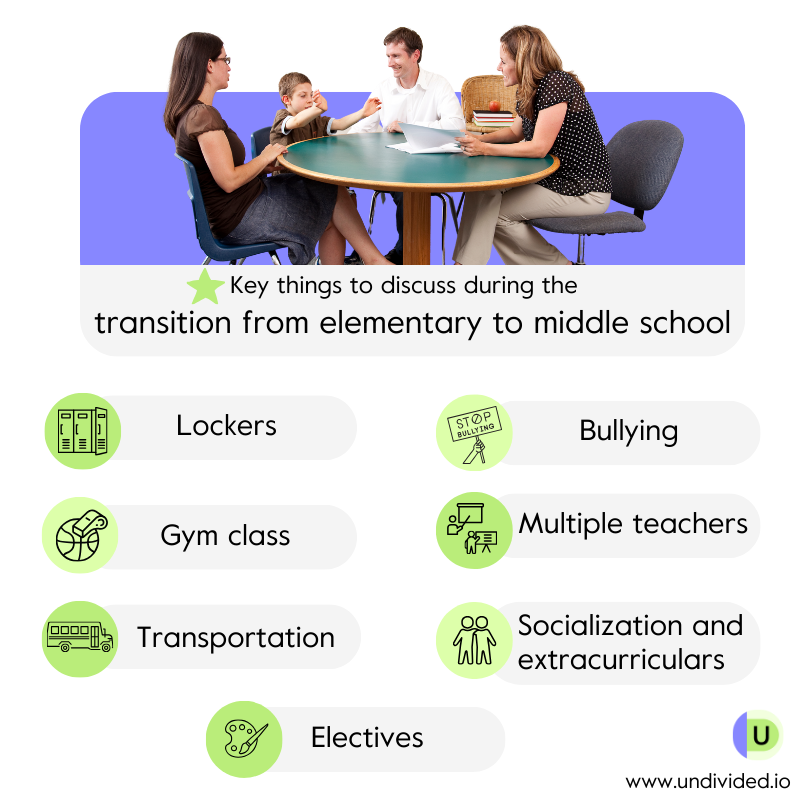Making the Transition to Middle School with an IEP
The transitions from preschool to kindergarten, elementary to middle school, and middle to high school are rites of passage, and while they can be equal parts thrilling and terrifying for students and parents alike, these transitions often come with extra challenges for kids with disabilities and their families. This series looks at ways to make these leaps as painless as possible.
You might not remember from your own experience, but graduating from elementary school to middle school significantly shakes up a child’s daily routine. They have to learn to navigate a bigger school, a cafeteria that might as well be the Wild West, multiple teachers and classrooms, changing clothes in gym class, and using a locker, among other things. “I think all of these transitions are pretty scary for families,” says Dr. Sarah Pelangka, special education advocate and owner of Know IEPs.
Transition from elementary to middle school: transition meetings
Transition meetings, which are separate from the annual IEP meeting, are an opportunity for parents to address some of their concerns. Most transition meetings are scheduled for 30 minutes, which Dr. Pelangka says is far too short to cover all the bases. While you can always request a continuation, it’s best to ask the IEP team to block out at least an hour for the discussion.
One of the major questions the meeting will address is which school your child will attend. Districts usually recommend feeder schools, but you’ll want to do your homework on every option: what the facilities are like, the curriculum, where most of your child’s close peers are going. Dr. Pelangka recommends scheduling a school tour, in person or virtually, before your transition meeting. You should also make sure that representatives from any school you’re seriously considering are invited to the transition meeting.
Note that the transition process might take longer than you anticipate. If you think there might be a placement issue, work with your school district to schedule your child’s transition IEP for March or April rather than June so that you have plenty of time to resolve any disagreements.
What to ask when touring schools
When you tour each potential middle school, here are some questions to keep in mind:
What is the physical space like? Can your child navigate a large campus easily? Is it near a busy road? Where are the restrooms and cafeteria located? Consider safety issues, such as whether the parking lot is gated. Remember that you can ask for a physical therapy evaluation to come up with a plan to help your child navigate a new campus. Any new skills your child may need to adjust to their new school can be added as goals in their IEP.
Ask about the different “levels” offered for each class — such as honors and advanced programs, co-taught classes, resource rooms or learning centers, and special day classes — and ask to see each one. What are the special education classrooms like, and how do they compare to mainstream classrooms? Ideally, Dr. Pelangka says, you’ll want to tour during an actual class so you can see how the teacher interacts with the students and how the students interact with each other.
What kind of technology and other equipment does the school use? Is it the same in all classrooms (some schools have inferior tech in SpEd classrooms or none at all). If your child has auditory sensitivities, how are the acoustics?
If your child’s IEP specifies that they receive therapy services or adapted physical education (APE) in a separate classroom, ask to see those areas as well.
What is the school’s lunchtime routine? Will your child need an aide during lunch to help them navigate the cafeteria environment? What other adjustments may be necessary for transitioning them to their new lunch routine?
Will your child be able to find their classrooms and navigate class transitions independently? If you’re concerned about this, ask if the school can provide an aide or a peer in between classes, even if it’s just temporary until your child gets acclimated.
There’s no recess in middle school, so ask about opportunities for your child to socialize. Find out if the school has buddy clubs, friendship circles, or lunch clubs. “The clubs for middle school and high school are huge,” says Dr. Pelangka. You can request a list and encourage your child to attend and work on social goals during that time. If they have a special interest, you can work with the school to help them start their own club.
If your child needs a movement or regulation break that was typically available during recess in elementary school, you may want to discuss other ways your child can get this release during their school day.
Ask about any special equipment your child requires and how it will be supported in each of their classrooms. If your child uses a cell phone to communicate with you or to take photos of class materials, ask about the school’s policy on phones and whether students can have them in class.
While it can be time-consuming, gathering all of this information on potential schools ahead of time will be useful in your transition meeting. If you can narrow your choice of schools to your top pick, you’ll have more time to devote to other issues. And there are plenty!
For a handy chart you can print out and bring with you to take notes, see our school tour checklist for Undivided members.
Middle school routine checklist
Middle school involves some significant changes in routine. Some specific areas Dr. Pelangka sees many children struggle with include:
Lockers: Some kids may have trouble with the fine motor or other skills required to operate a locker. You can request a key-style lock instead of a combination lock, and ask that the office hold a copy of the key; your child can keep a copy in a place they won’t lose it, such as on a pocket keychain, backpack, or a lanyard around their neck. You can also ask that using a lock be added as an occupational therapy goal in your child’s IEP so that by the time the transition happens, they have mastered the skill. Another option might be to avoid lockers altogether and instead use a rolling backpack for books and supplies. Don’t forget about separate lockers for PE.
Gym class: Most schools require kids to change for PE. Will that be an issue for your child? Aides are not usually allowed in the locker rooms, but other accommodations can be made, such as using a nurse’s office or staff bathroom. Decide what will be the least restrictive choice for your child and spell out the details clearly in the IEP. You might consider asking the school to provide push-in services such as APE instead of pulling your child out during PE, so your child can benefit from the socialization that happens during gym class. Dr. Pelangka also reminds us to “make a plan for menstrual cycle needs if your child requires assistance from the nurse.”
Transportation: Find out if your child will be riding a general education bus. “Sometimes you have to push for alternate transportation because it may not be safe for your child on a general education bus,” says Dr. Pelangka. Many middle schools do not allow parents on campus; if you will be picking up your child, ask if an aide can accompany your child to the designated pick-up area until they’ve learned the routine.
Bullying: Unfortunately, this can be a huge issue, especially in middle and high school, says Dr. Pelangka. Parents naturally want to protect their children against even the possibility of being bullied, but, she says, the law doesn’t work that way. “You can’t request an aide just in case your child is bullied,” she says. “And it can be challenging to prove bullying.” If you have concerns about bullying, request that a school psychologist or guidance counselor attend the transition meeting so you can discuss your concerns in detail. What kinds of support do the counselors provide? You can also ask what the school’s anti-bullying program looks like, and work with the PTA or PTSA and Associated Student Body to organize an anti-bullying program such as a kindness week. See our article on bullying for more resources.
Multiple teachers: The master schedule in a middle school is complex. Unlike elementary school, in middle school your child may have as many as six teachers, and they won’t all be aware of your child’s IEP. Often only the case carrier will read it. As soon as you receive your child’s schedule, it’s a good idea to email each teacher your child will interact with, as well as the school counselor, to introduce yourself and your child’s strengths and challenges. Talk about any relevant IEP goals you’d like them to be aware of. Offer your support and ask them to contact you if there are any issues.
Socialization and extracurriculars: Ask what kinds of programs the school offers to help incoming middle schoolers meet peers and acclimate to their new environment. Do they provide any opportunities to help students with disabilities assimilate? Make sure you also ask what extracurricular activities the school offers that your child might like to participate in. (Remember that your child is entitled to an aide for any extracurriculars, just as they are entitled to one in the classroom.) It’s also a good idea to connect with the school’s special needs or diversity parent group, if they have one.
Electives: You may want to ask whether — as is commonly the case — using the resource room for remediation and tutoring is considered an elective, and if spending time there will cause your child to miss out on fun activities like band and art. How will you handle this? If you choose the resource room, think about how you might expose your child to creative learning outside of school. If you opt to have them attend the fun electives, can you find a tutor to work with them after school?
Familiarize your child with the school
Once you know which school your child will be going to, you’ll want to make sure they take part in any general education tours, open houses, or camps the school sets up for transition. You can also check out our checklist for navigating a new campus.
Finally, remember that anything that isn’t working can be changed. Make sure to request and schedule your child’s next IEP meeting for 30 days after the start of school. This 30-day review will give you a chance to see how things are working and make any necessary adjustments.
Is your child preparing to transition to middle school? Make the process easier with the step-by-step guide in the Undivided app!
Transition to middle school
Join for free
Save your favorite resources and access a custom Roadmap.
Get StartedAuthor




